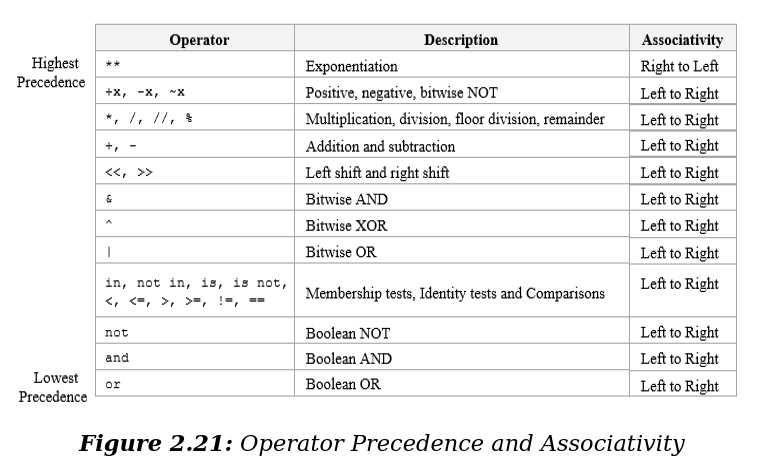>>> help()
help> PRECEDENCE
Operator precedence
*******************
The following table summarizes the operator precedence in Python, from
highest precedence (most binding) to lowest precedence (least
binding). Operators in the same box have the same precedence. Unless
the syntax is explicitly given, operators are binary. Operators in
the same box group left to right (except for exponentiation and
conditional expressions, which group from right to left).
Note that comparisons, membership tests, and identity tests, all have
the same precedence and have a left-to-right chaining feature as
described in the Comparisons section.
+-------------------------------------------------+---------------------------------------+
| Operator | Description |
|=================================================|=======================================|
| "(expressions...)", "[expressions...]", "{key: | Binding or parenthesized expression, |
| value...}", "{expressions...}" | list display, dictionary display, set |
| | display |
+-------------------------------------------------+---------------------------------------+
| "x[index]", "x[index:index]", | Subscription, slicing, call, |
| "x(arguments...)", "x.attribute" | attribute reference |
+-------------------------------------------------+---------------------------------------+
| "await x" | Await expression |
+-------------------------------------------------+---------------------------------------+
| "**" | Exponentiation [5] |
+-------------------------------------------------+---------------------------------------+
| "+x", "-x", "~x" | Positive, negative, bitwise NOT |
+-------------------------------------------------+---------------------------------------+
| "*", "@", "/", "//", "%" | Multiplication, matrix |
| | multiplication, division, floor |
| | division, remainder [6] |
+-------------------------------------------------+---------------------------------------+
| "+", "-" | Addition and subtraction |
+-------------------------------------------------+---------------------------------------+
| "<<", ">>" | Shifts |
+-------------------------------------------------+---------------------------------------+
| "&" | Bitwise AND |
+-------------------------------------------------+---------------------------------------+
| "^" | Bitwise XOR |
+-------------------------------------------------+---------------------------------------+
| "|" | Bitwise OR |
+-------------------------------------------------+---------------------------------------+
| "in", "not in", "is", "is not", "<", "<=", ">", | Comparisons, including membership |
| ">=", "!=", "==" | tests and identity tests |
+-------------------------------------------------+---------------------------------------+
| "not x" | Boolean NOT |
+-------------------------------------------------+---------------------------------------+
| "and" | Boolean AND |
+-------------------------------------------------+---------------------------------------+
| "or" | Boolean OR |
+-------------------------------------------------+---------------------------------------+
| "if" – "else" | Conditional expression |
+-------------------------------------------------+---------------------------------------+
| "lambda" | Lambda expression |
+-------------------------------------------------+---------------------------------------+
| ":=" | Assignment expression |
+-------------------------------------------------+---------------------------------------+
-[ Footnotes ]-
[1] While "abs(x%y) < abs(y)" is true mathematically, for floats it
may not be true numerically due to roundoff. For example, and
assuming a platform on which a Python float is an IEEE 754 double-
precision number, in order that "-1e-100 % 1e100" have the same
sign as "1e100", the computed result is "-1e-100 + 1e100", which
is numerically exactly equal to "1e100". The function
"math.fmod()" returns a result whose sign matches the sign of the
first argument instead, and so returns "-1e-100" in this case.
Which approach is more appropriate depends on the application.
[2] If x is very close to an exact integer multiple of y, it’s
possible for "x//y" to be one larger than "(x-x%y)//y" due to
rounding. In such cases, Python returns the latter result, in
order to preserve that "divmod(x,y)[0] * y + x % y" be very close
to "x".
[3] The Unicode standard distinguishes between *code points* (e.g.
U+0041) and *abstract characters* (e.g. “LATIN CAPITAL LETTER A”).
While most abstract characters in Unicode are only represented
using one code point, there is a number of abstract characters
that can in addition be represented using a sequence of more than
one code point. For example, the abstract character “LATIN
CAPITAL LETTER C WITH CEDILLA” can be represented as a single
*precomposed character* at code position U+00C7, or as a sequence
of a *base character* at code position U+0043 (LATIN CAPITAL
LETTER C), followed by a *combining character* at code position
U+0327 (COMBINING CEDILLA).
The comparison operators on strings compare at the level of
Unicode code points. This may be counter-intuitive to humans. For
example, ""\u00C7" == "\u0043\u0327"" is "False", even though both
strings represent the same abstract character “LATIN CAPITAL
LETTER C WITH CEDILLA”.
To compare strings at the level of abstract characters (that is,
in a way intuitive to humans), use "unicodedata.normalize()".
[4] Due to automatic garbage-collection, free lists, and the dynamic
nature of descriptors, you may notice seemingly unusual behaviour
in certain uses of the "is" operator, like those involving
comparisons between instance methods, or constants. Check their
documentation for more info.
[5] The power operator "**" binds less tightly than an arithmetic or
bitwise unary operator on its right, that is, "2**-1" is "0.5".
[6] The "%" operator is also used for string formatting; the same
precedence applies.
Related help topics: lambda, or, and, not, in, is, BOOLEAN, COMPARISON,
BITWISE, SHIFTING, BINARY, FORMATTING, POWER, UNARY, ATTRIBUTES,
SUBSCRIPTS, SLICINGS, CALLS, TUPLES, LISTS, DICTIONARIES





 浙公网安备 33010602011771号
浙公网安备 33010602011771号